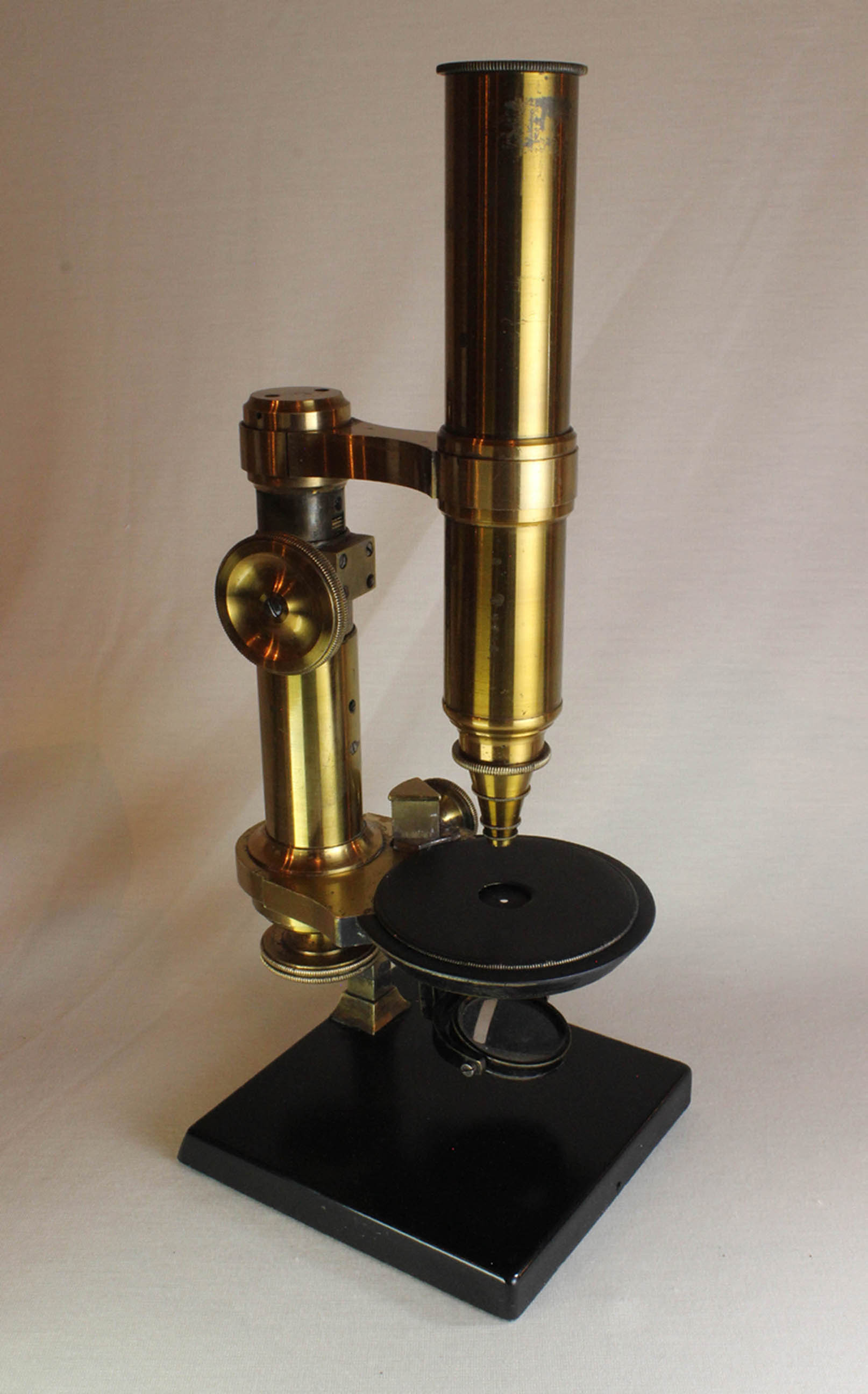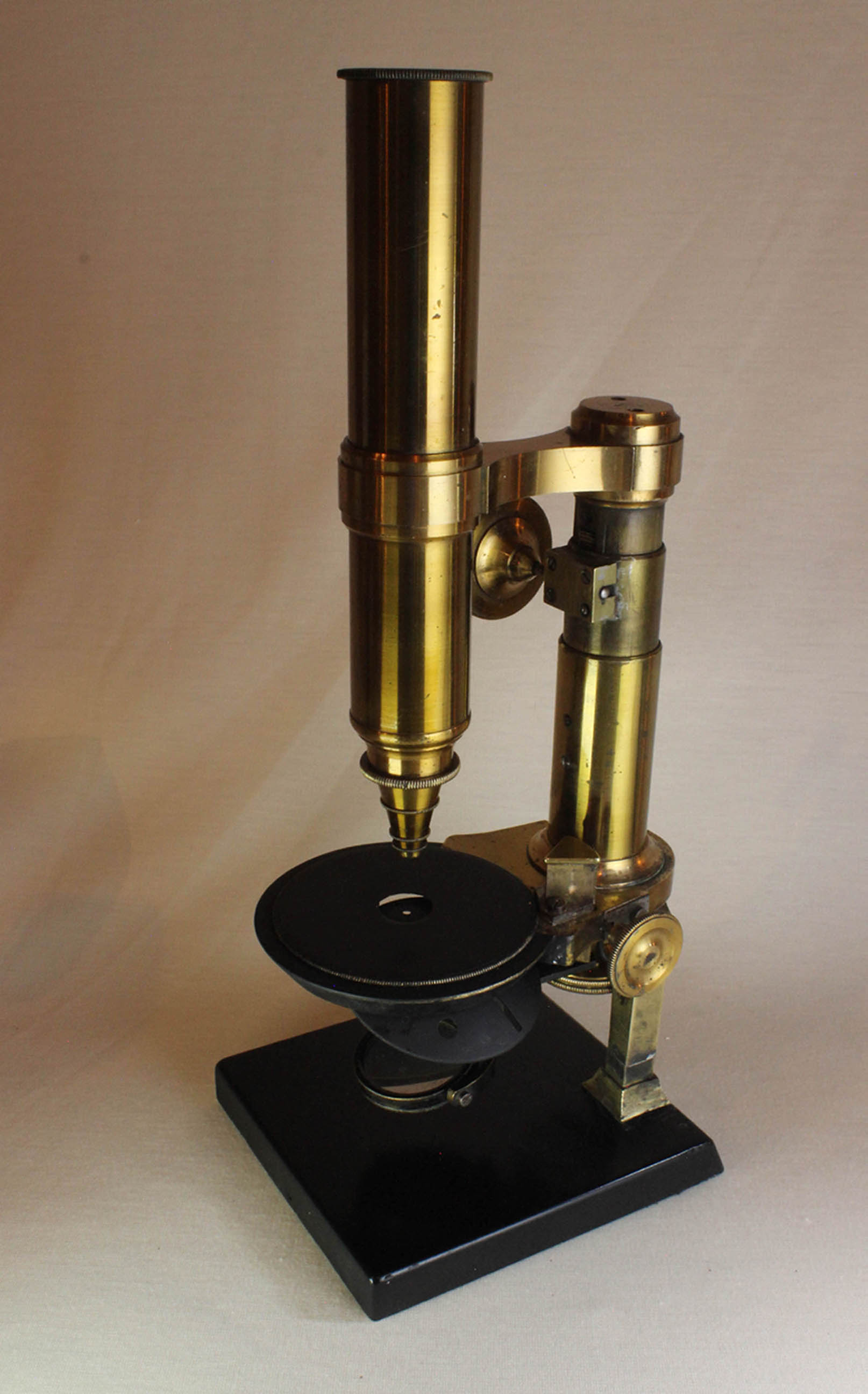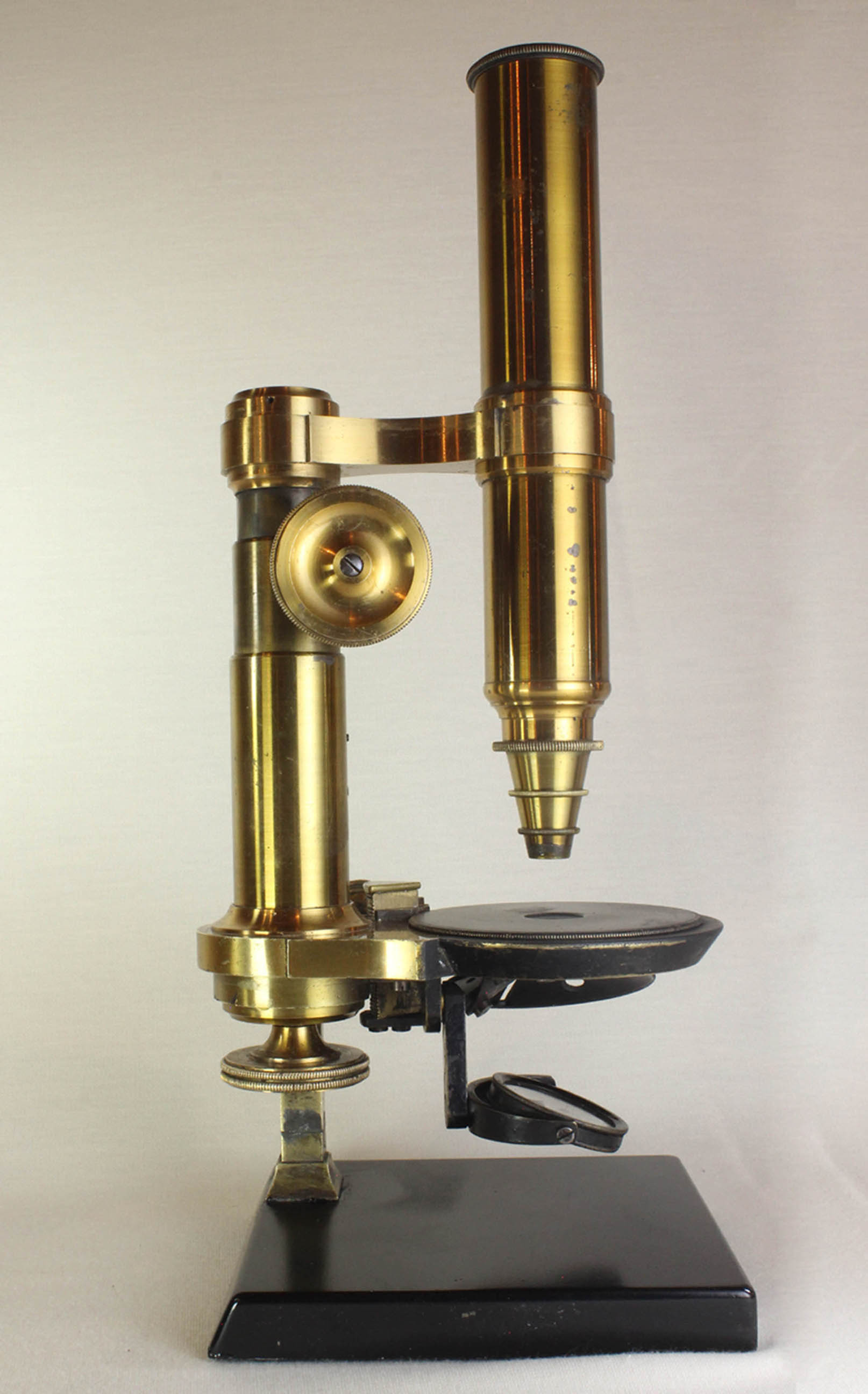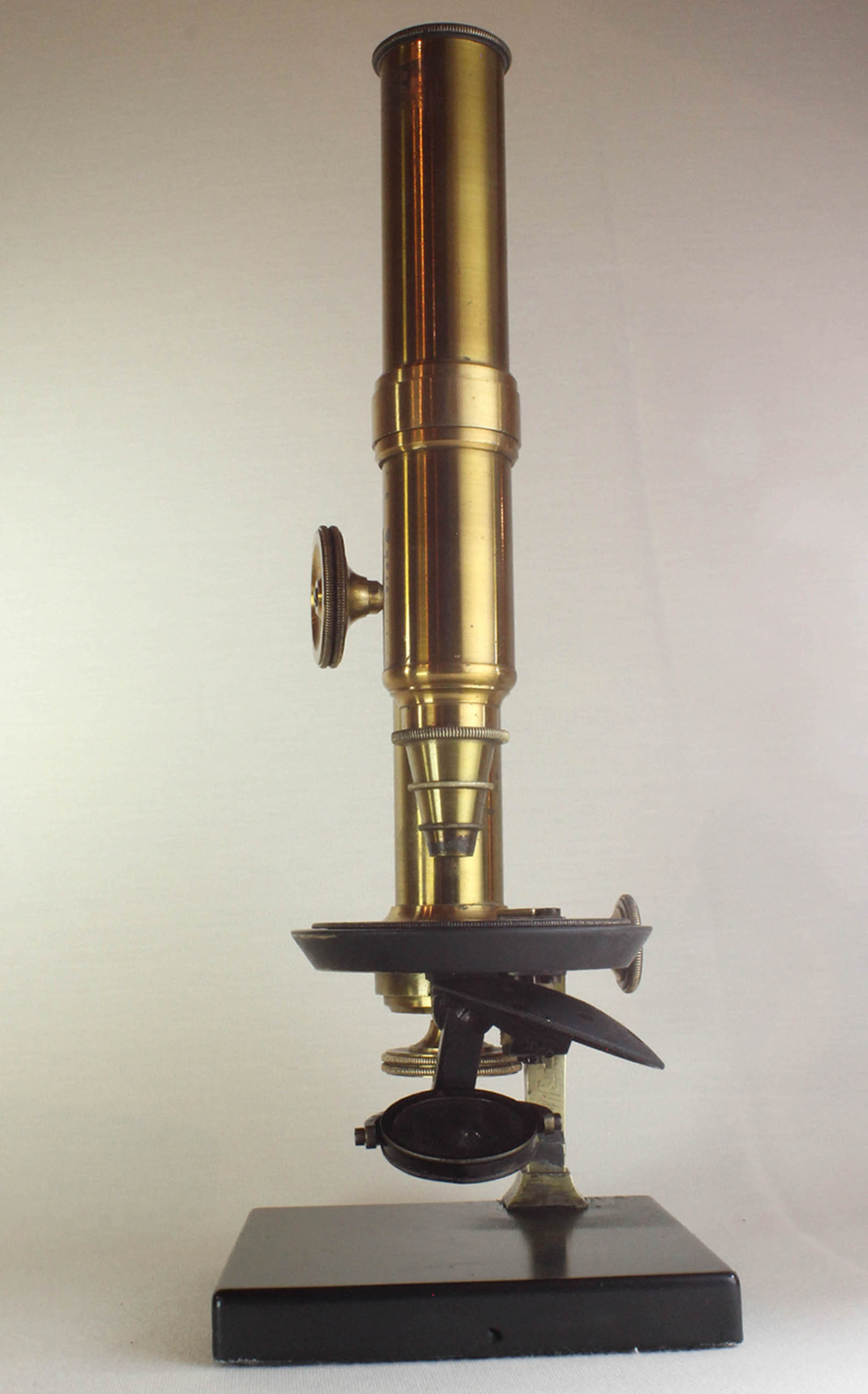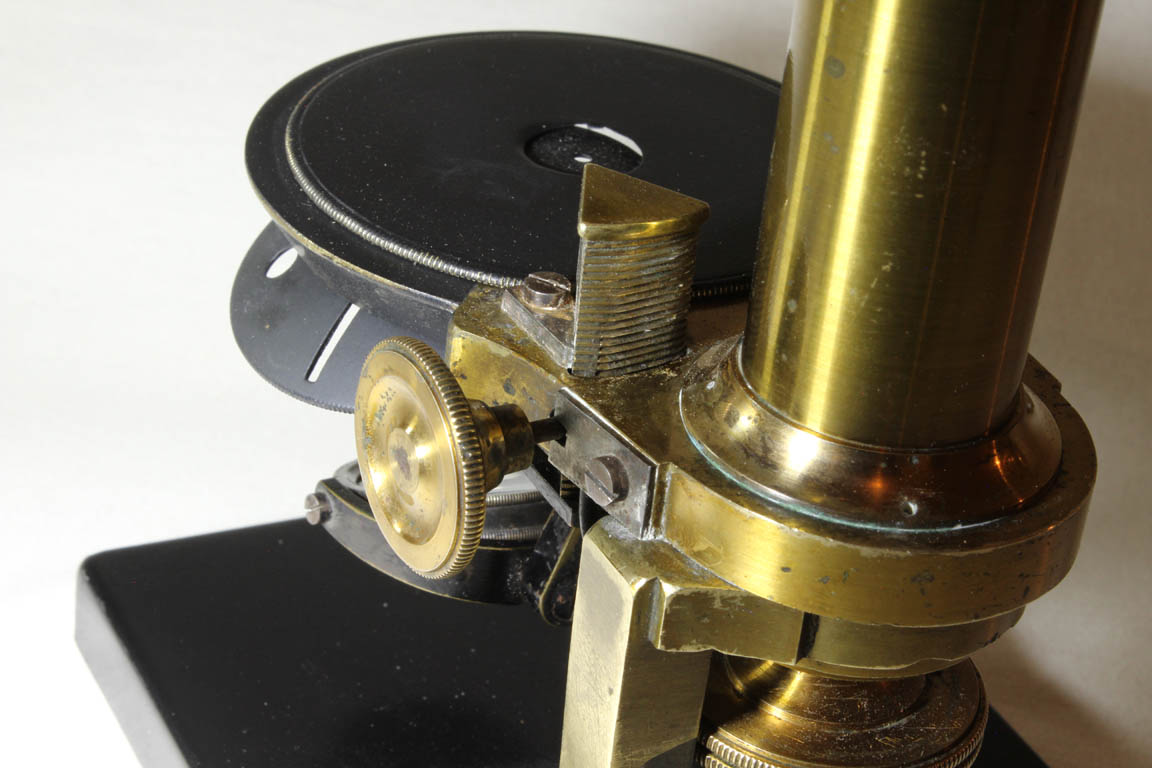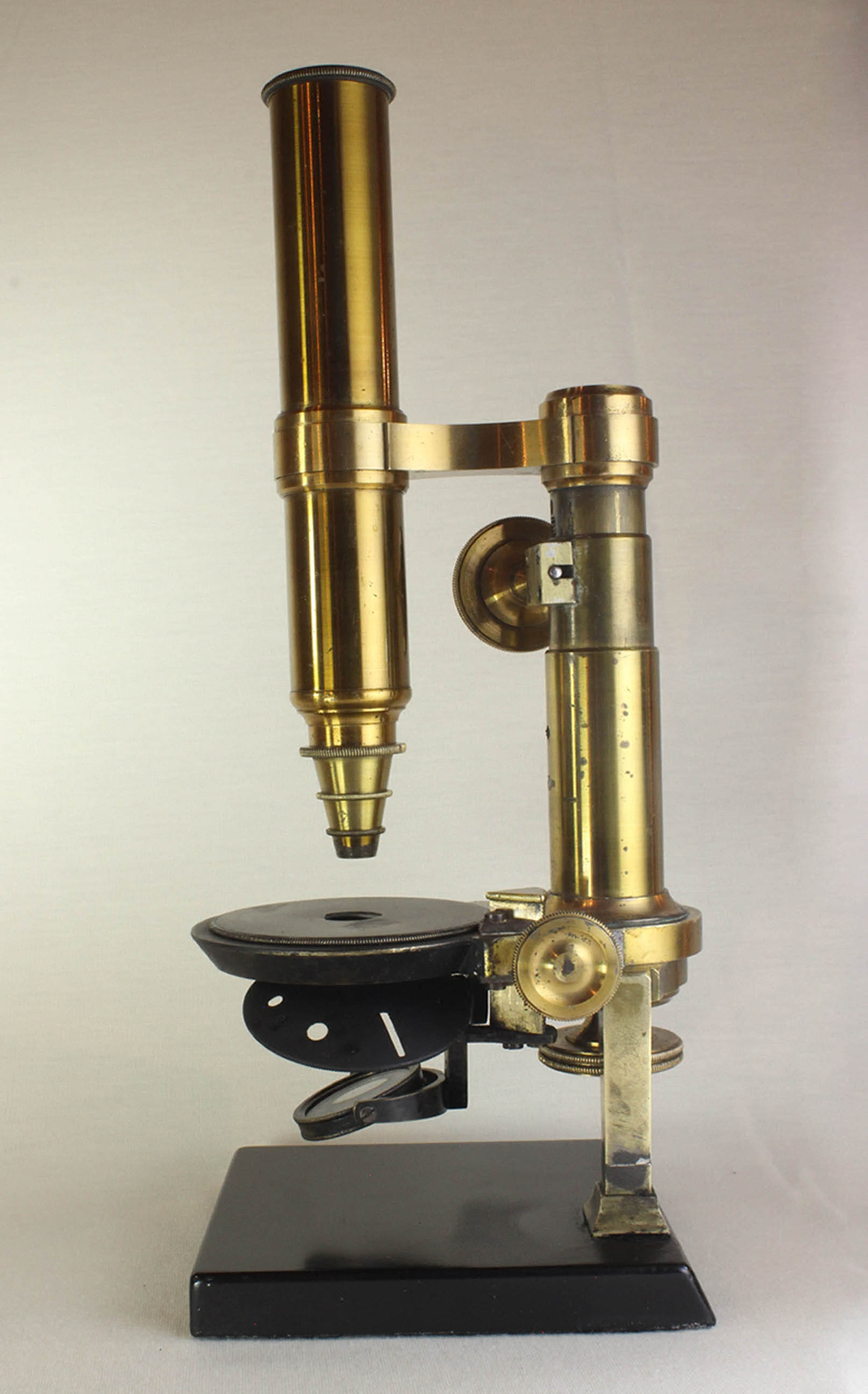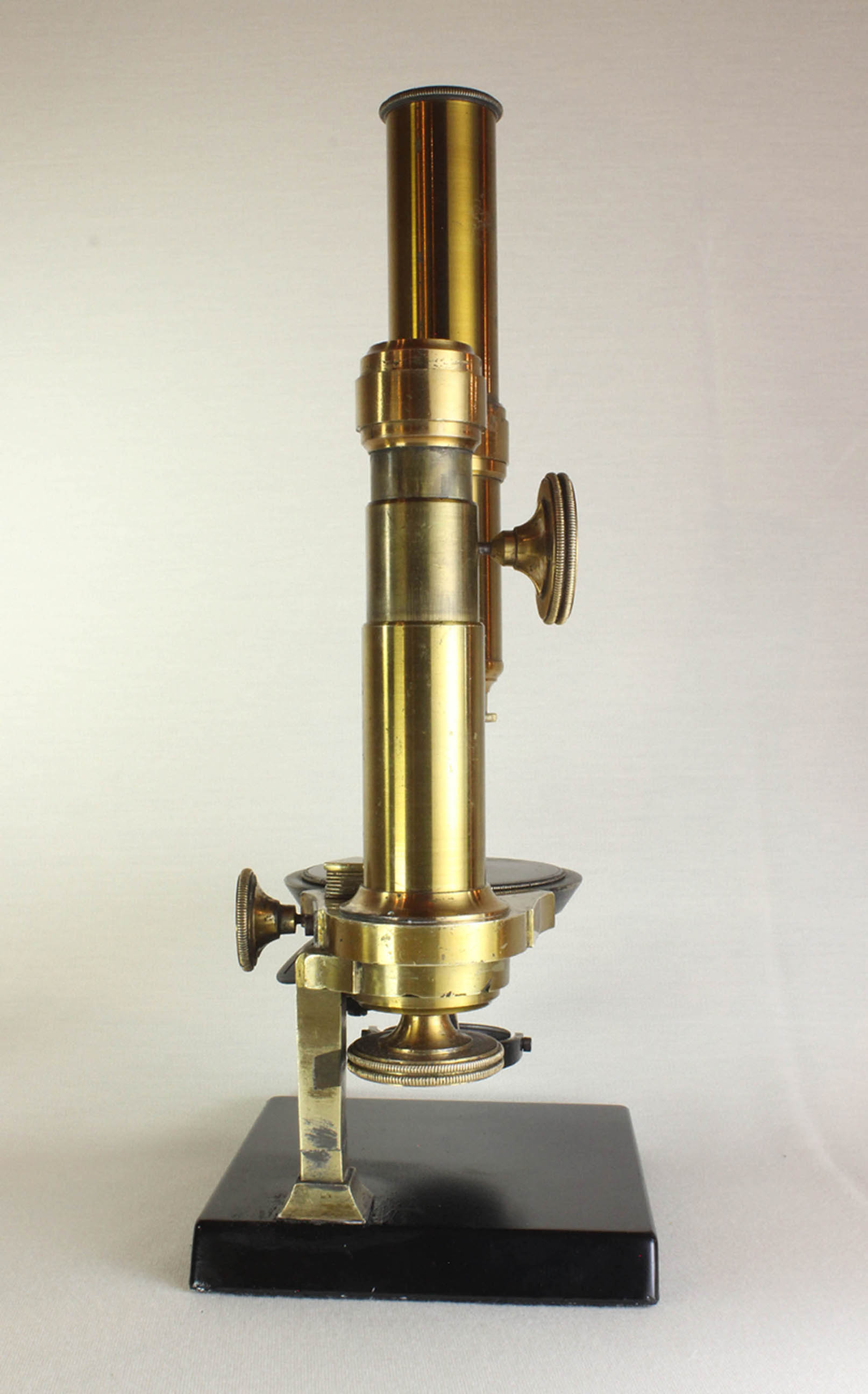DESCRIPTION: This
unusual, rare, and possibly unique microscope arises from a rectangular iron foot which is painted black, has rounded edges, and a slanted side only on the back edge, like many other microscopes from the early days of Wetzlar.
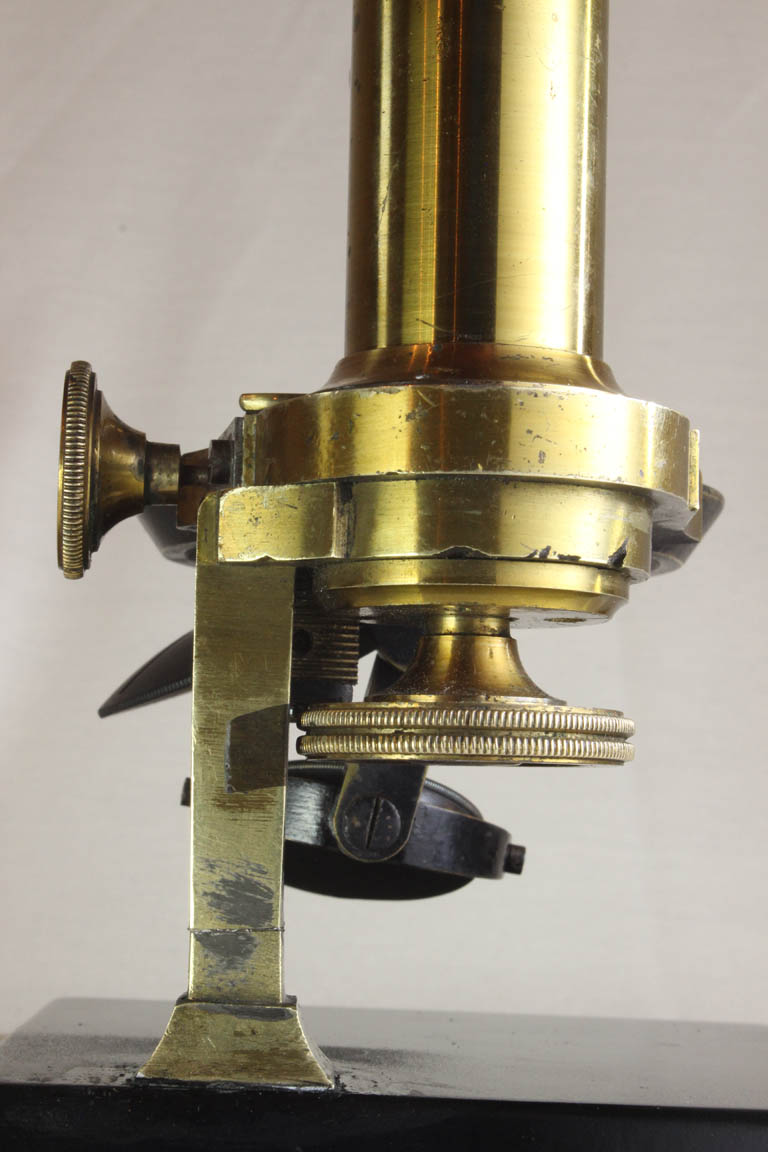
A rather thin single, brass pillar of square profile,
is screwed into the foot and forms the main support of the microscope. This support, in the shape of an inverted 'L' attaches from the side via a thick ring incorporated into the top horizontal portion of the inverted 'L'; the limb, passing through the stage, then passes through this ring, and is held on by the large round nut
which screws on to
the bottom of the limb. Thus the limb passes through the stage, and then through the ring of the inverted 'L' tightening around both. This L-shaped support is made of one piece of solid brass.
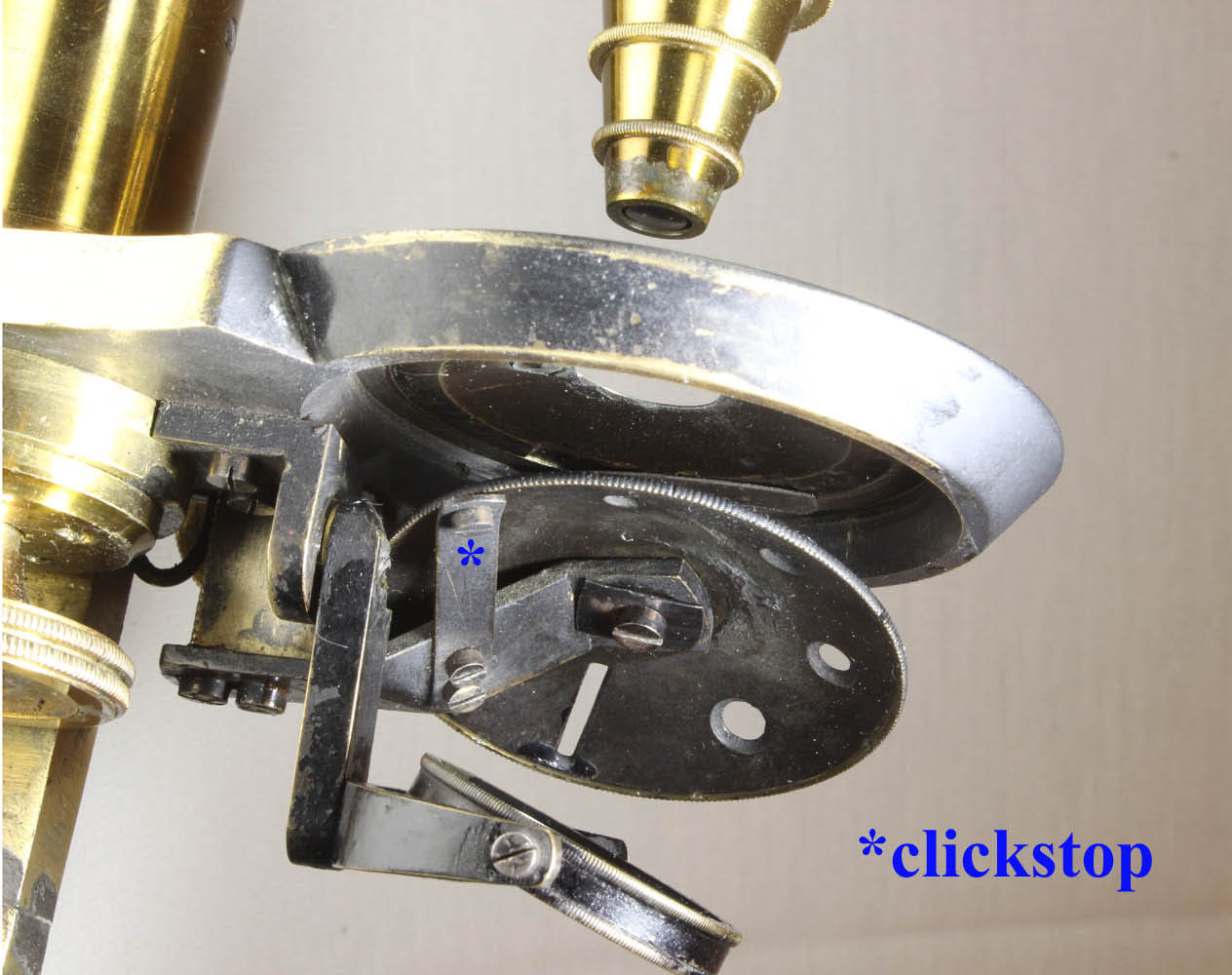 A swinging tailpiece supports a small single-sided concave mirror. The substage includes a conical wheel of apertures, including one slit for oblique illumination. There are click stops for each aperture. An unusual feature of this is the rack and pinion control of the distance of the apertures from the stage and the fact that the rack is nearly triangular and runs through the stage itself rather than being on a tail piece. The back edge of this triangle, the side with the rack, is actually rounded in shape. This wheel of apertures, or
A swinging tailpiece supports a small single-sided concave mirror. The substage includes a conical wheel of apertures, including one slit for oblique illumination. There are click stops for each aperture. An unusual feature of this is the rack and pinion control of the distance of the apertures from the stage and the fact that the rack is nearly triangular and runs through the stage itself rather than being on a tail piece. The back edge of this triangle, the side with the rack, is actually rounded in shape. This wheel of apertures, or stops
is permanently
attached; i.e. there is no provision for substituting a condenser.
Coarse focus is via a single knurled knob acting via straight rack and pinion to the round continental limb. The fine focus of that pillar is from under the stage with the knurled fine focus knob.
The stage center is round and has a knurled edge and can be rotated. It is held on by two narrow pieces of spring steel from under the stage, each held in place by a single tiny screw. There is no provision for stage clips.
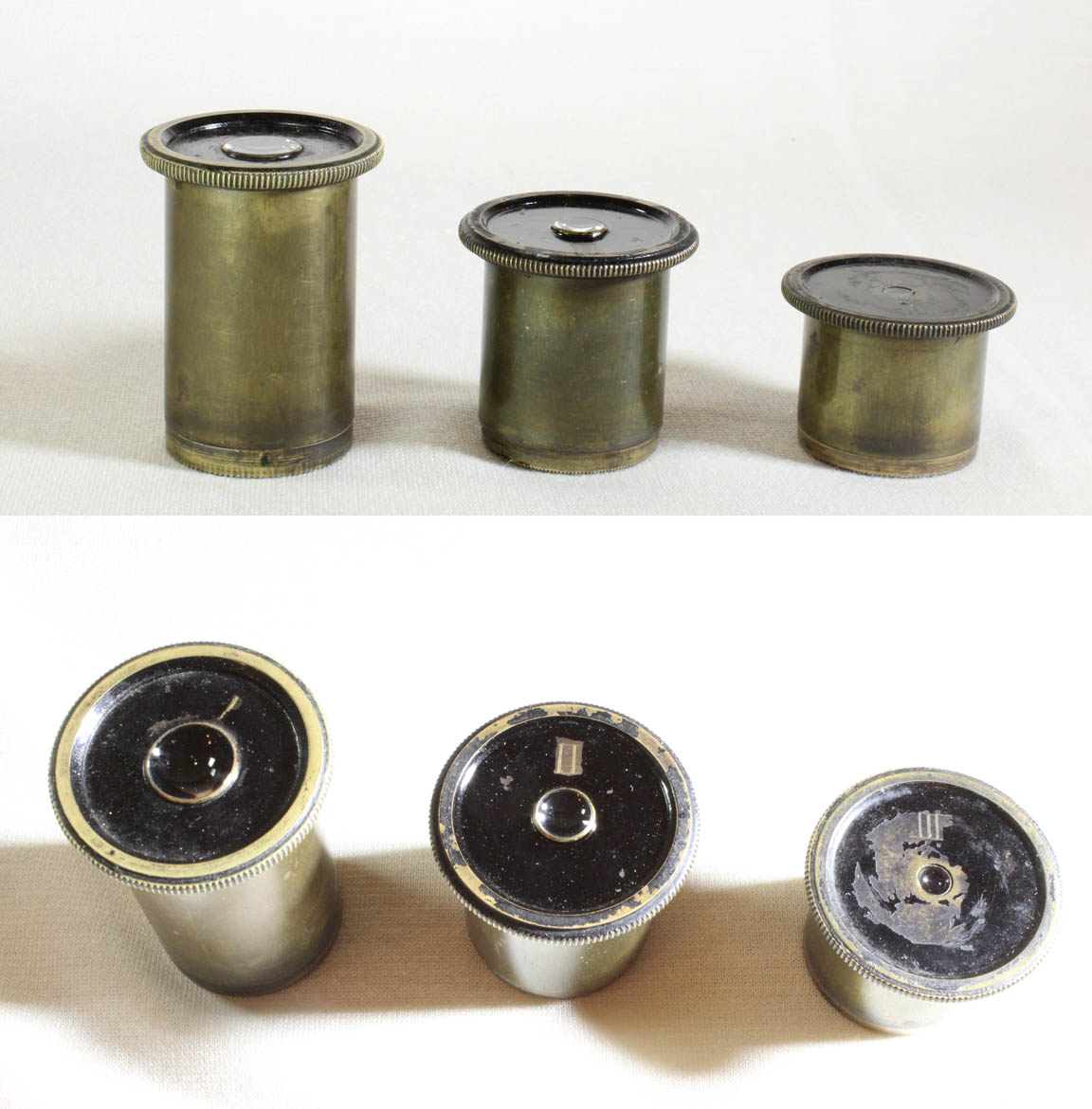
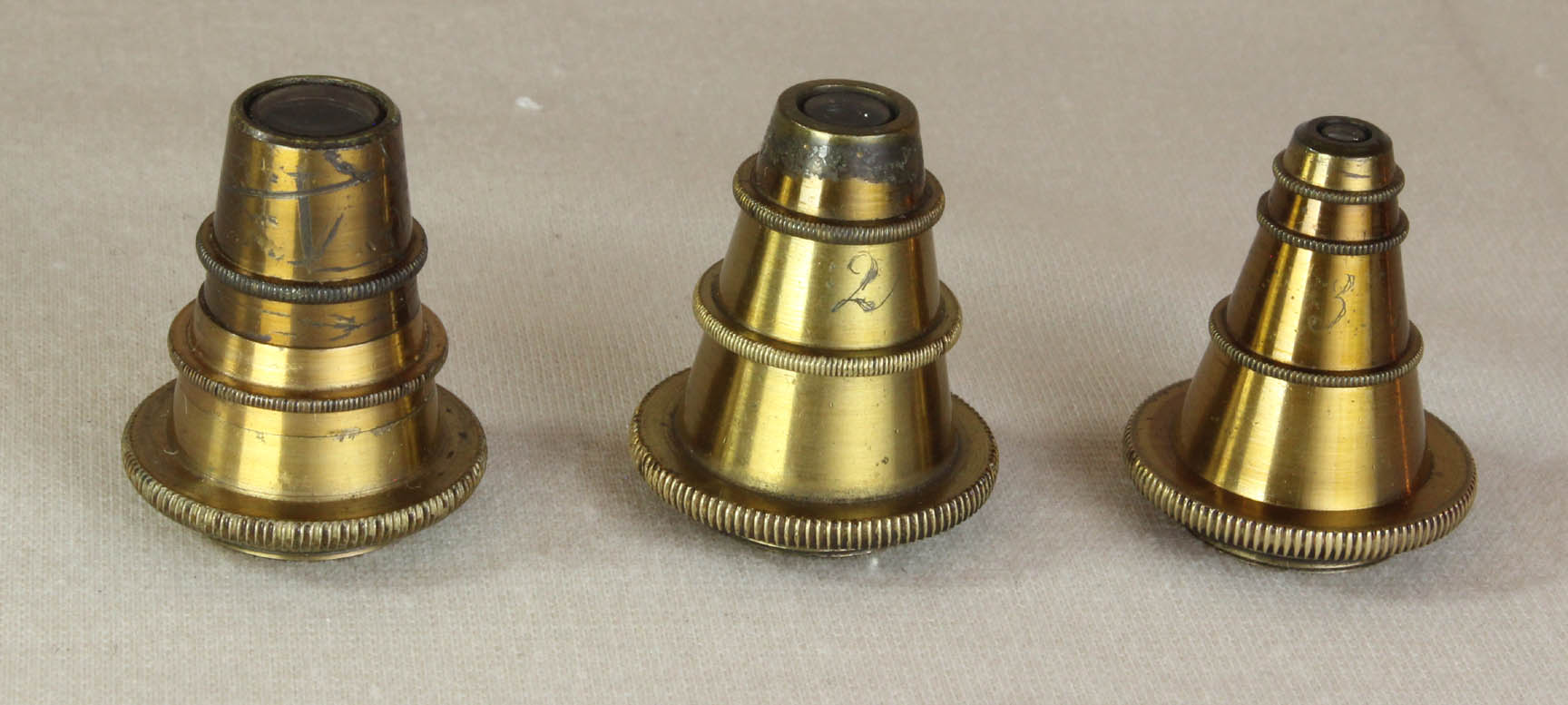
There are three oculars and three objectives. The oculars are
labeled in Roman numerals as I, II, and III. The objectives are labeled in Arabic numbers 1,2 and 3. The numbering of the objectives was done in a crude manner, using a sharp object to scratch these numbers on the objectives rather than formal engraving. This feature is typical of some of the
objectives on the microscopes from the Wetzlar Optical institute from this time period. The author is aware of signed Bethle objectives using this crude method of signing.
The original thick-walled, dovetailed wooden case has green felt linings to protect the contents and is of identical construction to the earliest known from the Wetzlar Optical Institute.
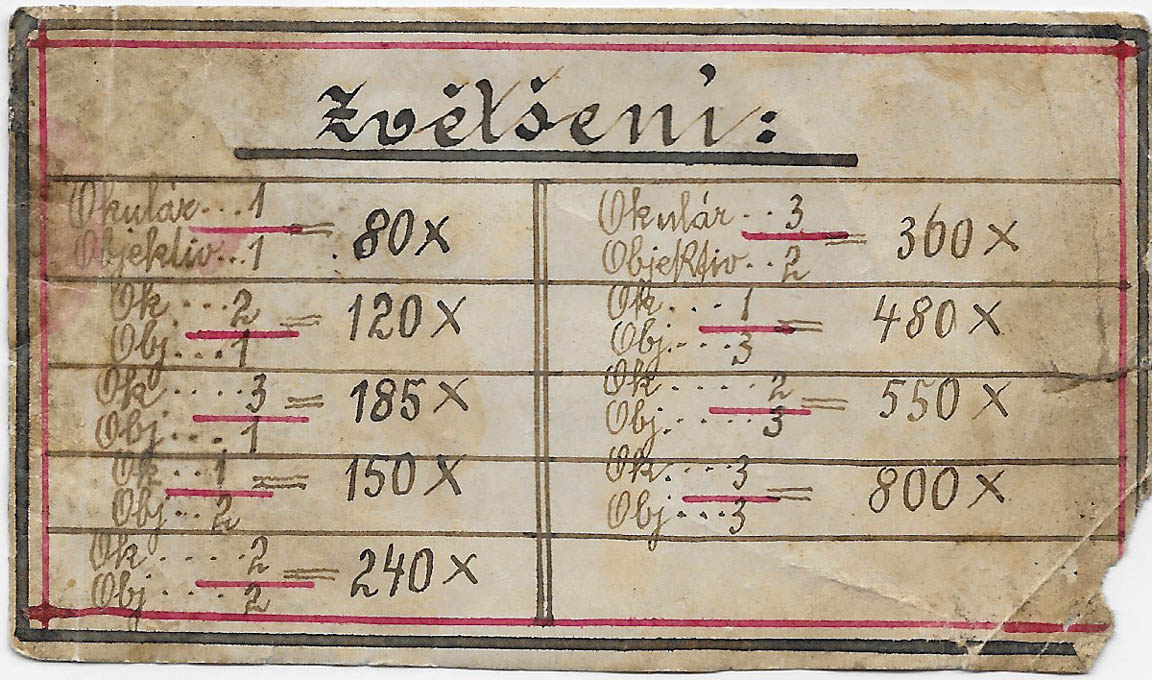
A very old pen and ink magnification card written in the Czech language is present. The word at the top is 'Zvětšení' which is Czech for magnification
. This instrument came to me from the Czech republic, so it is likely it had been there for many years.
NOTE ON CONDITION AND OPTICS: This microscope came to me with severe damage to the finish of the stage and foot. These areas were realistically refinished to, as much as possible, resemble the original finishes. The lacquer is all original, with a few minor losses, with the most obvious loss on the upright portion of the main support; the ring portion of this support retains its original lacquer. No lacquer restoration was done. I should also note a thin horizontal crack in the supporting pillar, but no apparent repair to it. The screws attaching it to the bottom plate apparently hold it together quite tightly.
The optics of this microscope are
really quite excellent. Mechanically it is in good condition, except for some loosening of the pinion box. The loosening is because one of the small brass screws holding on the pinion box cover is apparently stripped, and no longer holds the pinion box cover on tightly. Even with the latter problem, it is possible to use the coarse focus, albeit gently. All other mechanical parts work flawlessly.
HISTORY: Carl Kellner founded the Optical Institute of Wetzlar about 1849 with Moritz Hensholdt and became famous for his Orthoscopic Eyepieces for both the telescope and microscope. They produced microscopes by 1850. As his fame spread, his business increased. Unfortunately he died of tuberculosis in 1855 at a young age. Kellner's cousin and assistant, Ludwig Engelbert took over the company briefly. By December 1855, Christian Friedrich Belthle, another company workman, took over after marrying Kellner's widow. At that time, Engelbert and Hensholdt left the company and formed their own firm. In August of 1857 Heinrich F. Rexroth became a partner. By 1858 employees included Ernst Gundlach, and also Wilhelm and Heinrich Seibert all of whom became microscope makers in their own right. About 1861 Rexroth left the firm, but it is known he made some microscopes after that. Ernst Leitz joined the company in 1863 or 1864 and by October 1865 was a partner.
By about 1859 some of the stands included a black rectangular iron base with a slanted edge on the back side along with an iron pillar also black. Also by then, a triangular bar was used to support the arm through the main limb pillar above the stage, and fine focus below the stage. One of the hallmarks of this era was the practice of scratching the numbers of the objectives rather than formal engraving. This is seen in the objectives of this microscope. The cases were also virtually identical in color and construction to the one with this instrument. By 1859 another characteristic of some of Kellner's microscopes was the rotating knurled top stage plate set into the main stage support, a feature also seen on this microscope. Noting that this instrument has a flimsier brass support arising from the foot, and a circular focusing tube containing the rack, differing from models from 1859 on, I have concluded this might be an early model which was quickly abandoned in favor of the new designs, dating it to before 1859 but *Timo Mappes, an experienced and very knowledgable German microscope collector, believes it to be the work of Rexroth, dating to about 1865. Using a tube as a focusing stem is quite inferior to the triangular stem seen on most of these from 1859 on, but is known on a Rexroth microscope. Its objectives, foot, rotating stage
plate, and case are identical to details of microscopes of the Wetzlar makers including Belthle, and Rexroth. I should also note that the only signed microscopes known to me with the rectangular foot slanted only in the back, were signed by Belthle. Of the early Wetzlar makers, only Rexroth was known to use the round tube focus mechanism and his boxes were identical to the other early Wetzlar maker.
Whoever made it, it is clear this microscope was made in Wetzlar, most likely in the 1850's-1860's (circa 1865 if Timo Mappes is correct).
The rack and pinion focusing aperture wheel was apparently not
continued as it was likely more than was needed for such a basic type of condenser. On the other hand, this type of focus allowed oblique lighting to be used to advantage as the slit for oblique lighting could easily be set at the perfect distance from the stage which would differ for different conditions and objectives. The Wetzlar Maker's fame spread rapidly over Europe and with it sales to many other countries outside of Germany. It is not surprising then, that this microscope, which I obtained in 2015 from the Czech republic, has an old Czech magnification card, likely dating to the middle of the nineteenth century.
The author would like to acknowledge the help of Allan Wissner and Timo Mappes in supplying me with some of the historical information contained herein and fruitful discussions about it. I am also grateful to my long time close friend, James Solliday, for his advice, opinions, and encouragement about this and many other instruments in my collection. Without his help and insight, I might not have acquired this unusual and important instrument.
